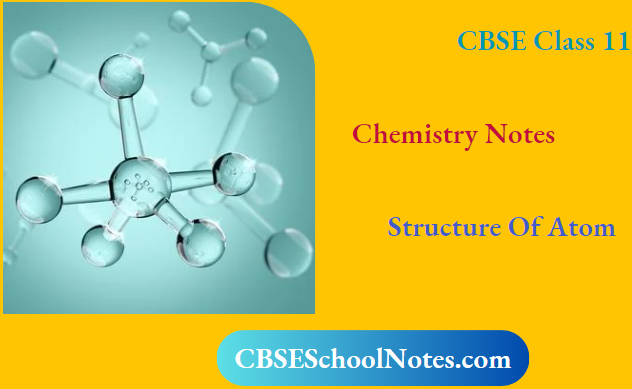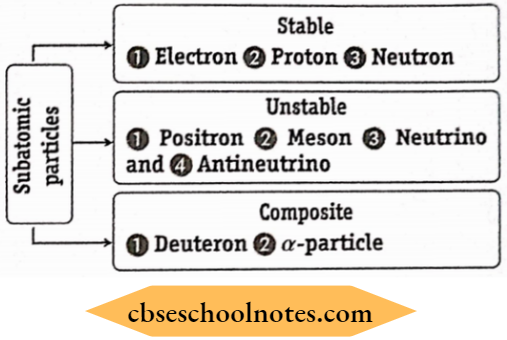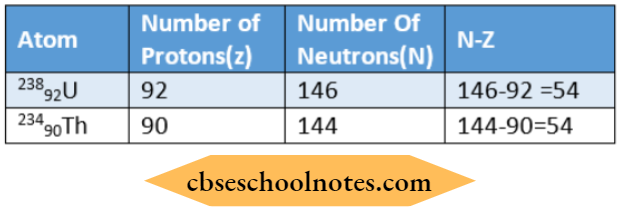Structure Of Atom Introduction

The Atomic theory of matter was first proposed by Sir John Daltonn (an English scientist) in 1808 his theory, called Dalton’s atomic theory was a landmark in the history of chemistry.
According to this theory, the atom is the smallest, indivisible, discrete particle of matter, which takes part in chemical reactions.
However, the research done by eminent scientists like J.J Thomson Goldstein, Rutherford, Chadwick, Bohr, and others towards the End Of the 19th Century and at the beginning of the 20th century has conclusively proved that atoms were no longer the smallest in divisible practice.
At present Scientists have identified about 35 different subatomic particles that may be divided under three heads which is shown in the adjacent table.
The three subatomic particles namely electrons, protons, and neutrons are the main constituents of an atom and are regarded as the fundamental particles.
Read and Learn More CBSE Class 11 Chemistry Notes

Atomic Number, Mass Number, Isotope, Isobar And Isotone
Atomic number
The atomic number indicates the total number of unit positive charges present in the nucleus of an atom.
As each proton carries a unit positive charge, the total number of protons present in the nucleus of an atom represents the atomic number of the corresponding element.
As an atom is electrically neutral, the total quantity of positive charge must be equal to that of negative charge carried by the electrons. So the number of protons is equal to the number of electrons.
Thus, the atomic number of the element = total number of protons in the nucleus ofthe atom = total number of electrons in the neutral atom
The atomic number determines the fundamental property of an element. No two elements can have the same atomic number.
Any difference in the number of electrons produces ions without altering the constitution ofthe nucleus.
In the modern version of the periodic table (both short and long), elements are arranged in the increasing order of their atomic numbers.
Mass number
Since the electrons have negligible masses, the mass of an atom is determined by the number of protons and neutrons present in the nucleus. The sum of the number of protons and neutrons present in the nucleus of an atom is called the mass number of that element.
Mass number (A) = No. of protons (Z) + No. of neutrons (N)
Example: The nucleus of a fluorine atom contains 9 protons and 10 neutrons. Therefore, the mass number of fluorine =9+10=19.
Generally, the atomic number (Z) and mass number (A) of an element are represented along with the symbol (X) ofthe element as shown below.
Here mass number A and atomic number Z are inserted as superscripts (to the left or right side) and subscripts (to the left side) of the symbol of the element respectively.
Thus, the symbol \({ }_{17}^{35} \mathrm{Cl} \text { or }{ }_{17} \mathrm{Cl}^{35}\) denotes a chlorine atom with mass number 35 and atomic number 17.
Isotope
According to Dalton’s atomic theory, all atoms of an element are identical in all respects.
However British chemist F. Soddy pointed out for the first time one limitation of this theory when he observed that the same element may have atoms with different atomic masses.
This is because atoms of the same element always contain the same number of protons but they may have different numbers of neutrons, which lead to differences in mass numbers. This phenomenon is known as isotopy.
Isotope Definition: Atoms Of the same element having the same atomic number but different mass numbers are called isotopes.
Example: Hydrogen has three isotopes, protium (H), deuterium (D), and tritium (T) with mass numbers 1, 2, and 3 respectively.
All three isotopes have the same atomic number 1, and they are represented as \({ }_1^1 \mathrm{H},{ }_1^2 \mathrm{H} \text { and }{ }_1^3 \mathrm{H}\) respectively.
Isotopes of other elements (some examples are given below) have no such special names; they are represented by simply indicating the values of mass number and atomic number on their symbol.
Thus isotopes ofchlorine are represented as and \({ }_{17}^{35} \mathrm{Cl} \text { and }{ }_{17}^{37} \mathrm{Cl} \text {. }\)
Characteristics: The characteristics of isotopes are—
The chemical properties of the isotopes of an element are the same. This is because the chemical properties of an element are determined by the number of electrons present in its atom, which in turn is equal to the number of protons present in the nucleus (and hence its atomic number).
However, the different isotopes of an element react at different rates. The lighter isotopes react faster and the reactions involving the heavier isotopes occur slowly.
The physical properties of the isotopes e.g., density, rate of diffusion, etc., which depend on the atomic masses are different.
All the isotopes of an element occupy the same position in the periodic table, although they have different atomic masses. The Greek word isotopes means the place (/so = same, topes = place).
Isotopes may be both radioactive and non-radioactive. The emission of one a -particle and two beta -particles from a radioactive element produce an element that occupies the same place as that of the parent element in the periodic table, although the mass number of the end (daughter) element is 4 units less than that of the parent element So, it will be an isotope of the parent element.
Example: \({ }_{92} \mathrm{U}^{238}\)(Uranium-I) and \({ }_{92} U^{234}\) (Uranlum-Il) are isotopes of the element uranium.
⇒ \({ }_{92}^{238} \mathrm{U} \stackrel{-\alpha}{\longrightarrow} \quad{ }_{90}^{234} \mathrm{Th} \quad \stackrel{-\beta}{\longrightarrow}{ }_{91}^{234} \mathrm{~Pa} \stackrel{-\beta}{\longrightarrow}{ }_{92}^{234} \mathrm{U}\)
Uranium-1 Uranium-9 Uranium-X2 Uranium-2
Different isotopes of an element may have different radioactive properties. Thus \({ }_6^{14} \mathrm{C}\) is not radioactive, while \({ }_6^{14} \mathrm{C}\) exhibits radioactivity.

Elements which do not have natural isotopes: Be-9, F-19, Na- 23, Al-27, P-31, Sc-45, Mn-55, Co-59, As-75, Y-89, Nb-93, Rh-103, 1-127, Cs-133, Pr-141, Tb-159, Ho-165, Tm-169, Au-197, Bi-209. The elements Sn and Xe have 10 and 9 isotopes respectively.

Isobar
Isobar Definition: Atoms having the same mass number but different atomic numbers are called isobars.
Example: \({ }_{18}^{40} \mathrm{Ar} \text { and }{ }_{20}^{40} \mathrm{Ca}\) are isobars. Here, Ar and Ca have the respective atomic numbers, 18 and 20.
Therefore, the number of their protons is 18 and 20 respectively, but the total number of protons and neutrons in both cases is 40. Number of neutrons in \({ }_{18}^{40} \mathrm{Ar}=(40-18)=22\) number of neutrons in \({ }_{20}^{40} \mathrm{Ca}=(40-20)=20\)
Although isobars have the same mass number, their atomic numbers are different. Thus isobars are atoms of different elements displaying different physical and chemical properties. They occupy different positions in the periodic table. Other examples of isobars are
⇒ \({ }_1^3 \mathrm{H},{ }_2^3 \mathrm{He}\)
⇒ \({ }_6^{14} \mathrm{C},{ }_7^{14} \mathrm{~N}\)
⇒ \({ }_{51}^{123} \mathrm{Sb},{ }_{52}^{123} \mathrm{Te}\)
⇒ \({ }_{88}^{228} \mathrm{Ra},{ }_{89}^{228} \mathrm{Ac},{ }_{90}^{228} \mathrm{Th}\)
⇒ \({ }_{88}^{228} \mathrm{Ra}^{228}{ }_{89}^{228} \mathrm{Ac},{ }_{90}^{228} \mathrm{Th}\)
⇒ \({ }_{82}^{210} \mathrm{~Pb},{ }_{83}^{210} \mathrm{Bi},{ }_{84}^{210} \mathrm{Po}\)
Isotone
Isotone Definition: Atoms having the same number of neutrons but a different number of protons are called isotones.
Consequently, isotones possess different mass numbers.
Example: \({ }_1^3 \mathrm{H} \text { and }{ }_2^4 \mathrm{He}\) The former contains 1 proton and 2 neutrons, while the latter contains 2 protons and 2 neutrons.
Isotopes are atoms of different elements having the same number of neutrons but different atomic numbers (number of protons).
They occupy different positions in the periodic table and have different physical and chemical properties.
Some Other examples are-
⇒ \({ }_1^3 \mathrm{H},{ }_2^4 \mathrm{He}\)
⇒ \({ }_{14}^{30} \mathrm{Si},{ }_{15}^{31} \mathrm{P},{ }_{16}^{32} \mathrm{~S}\)
⇒ \({ }_{33}^{77} \mathrm{As},{ }_{34}^{78} \mathrm{Se}\)
⇒ \({ }_6^{14} \mathrm{C},{ }_7^{15} \mathrm{~N},{ }_8^{16} \mathrm{O}\)
Comparative Study Of Isotope, Isobar And Isotone

A nuclear isomer is a diaper and isostere Amtoic (nuclides) having the same atomic number and mass number but different radioactive properties are called nuclear isomers and this phenomenon is known as nuclear isomerism.
The nuclei of a radioactive element which exist in different energy states are nuclear isomers.
Examples:
- U-X2 (tl/2 = 1.14 min) and U-Z (tl/2 = 6.7 hr.)
- 69Zn (tl/2 = 13.8 hr) and 69Zn (tl/2 = 57 min)
- 80Br (tl/2 = 4.4 hr) and 80Br (tl/2 = 18 min)
Isodiapher Atoms m which the difference between the number of protons is the same are called isodiapherr, An atomic nuclide and the atom produced from It due to the emission of an a-particle are isodiaphers.
Example: \({ }_{92}^{238} \mathrm{U} \stackrel{-\alpha}{\longrightarrow}{ }_{90}^{234} \mathrm{Th}\)

As the difference in the number of neutrons and protons In the two atoms are the same, they are isodiaphers.
Isostere Atom molecules or ions of similar sires containing the same number of atoms 3rd valence electrons are called isosteres.
Example:
Isosleric species involving cations and neutral atoms: Ne, Na+, Mg2+, Al3+.
Isosteric species involving anions and neutral atoms: N3–, O2–, F–, Ne.
Isosteric species involving cations, anions and mcutral atoms: O2– , F– , Ne, Na+, Mg2+
Isosteric species involving neutral molecules, cations and anions: 1. CN–, CO, NO+, N2 2. CO2, N2O, N2 (azide), OCN– (cyanate), SCN– (thiocyanate).
In general isosteric molecules and Ions have the same shape. In both NO2 and CO2, number of atoms =3 and number of valence electrons = 16. So, they are Isosteres.
